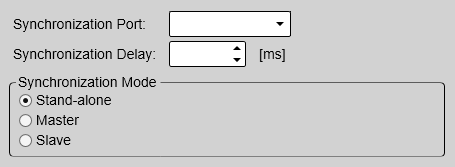Synchronization page
The purpose of the Synchronization parameters is to set up the EK80 system to operate alone, or as a master or slave in a synchronized system. Synchronization is required in order to avoid interference if the EK80 system is used simultaneously with other hydroacoustic instruments within the same frequency range.
Prerequisites
Several of the pages in the Installation dialog box are not available when your EK80 system is set to Replay mode. The Output dialog box is not available when your EK80 system is set to Inactive mode.
How to open
This page is located in the Installation dialog box. This page is also located in the Output dialog box.


To open, make a selection on the Operation or Setup menus.
Description
Whenever more than one hydroacoustic system is installed on a vessel, interference may occur. To avoid interference, you have these options:
| • | The systems are all connected to a common synchronization system. |
| • | One of the acoustic systems is set up as "master", and controls the transmissions on the other systems. |
The EK80 system offers functionality for remote transmit synchronization. It can be set up to operate in either Master or Slave mode.
Note
When you work in the Installation dialog box, you must always select Apply to save the changes made on a page. You must do this before you continue working on a different page.

Details
Synchronization Mode
Choose which synchronization mode to use.
For "slave" operation, a remote system (for example K-Sync or Simrad TU40) must be available to provide trigger pulses.
For "master" operation, a remote hydroacoustic system (sonar, echo sounder) is connected. This remote system must be set up in "slave" mode.
The synchronization mode is not fixed. It can be changed at any time during operation.
Note
Simultaneous transmission of more than one hydroacoustic system can only take place if the systems operate with different
frequencies.
Synchronization Delay
This delay parameter is used differently depending on the chosen synchronization mode.
| • | Stand-alone The Synchronization Delay setting is not applicable when synchronization is switched off.
|
| • | Slave In Slave mode, the EK80 system waits for the delay time after the external trigger signal has arrived before transmitting the ping. This is often referred to as a post-trigger.
|
Note
The Synchronization Delay functionality is unavailable if you use the Auxiliary port on your Wide Band Transceiver (WBT) to synchronize the EK80 system.
Synchronization Port
This is the interface port currently used to transmit or receive synchronization signals. It can be a serial port or a connection using the Auxiliary socket on the transceiver. Since the synchronization function only uses the Request To Send (RTS) and Clear To Send (CTS) signals on a serial port, you may be able to use a port that is already assigned other interface purposes. For the same reason, you do not need to define any baud rate.
Note
If you use more than one Wide Band Transceiver (WBT) in your EK80 system, all synchronization input signals to the Auxiliary ports must be provided by the same source. Individual synchronization of a single Wide Band Transceiver (WBT) is not supported.
If you use more than one computer in your EK80 system, the synchronization inputs to the Auxiliary ports can not be used. This functionality is not supported.
If you use the trigger functionality provided by the Auxiliary connector the Wide Band Transceiver (WBT), the EK80 can not operate in Master mode. This function is not supported by the EK80 system.